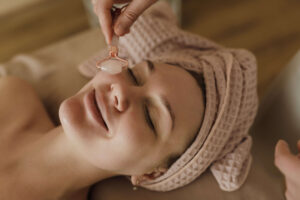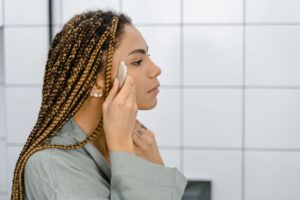Sculpt, Relax, Glow

In the fast-paced world of beauty routines and skincare, there’s a timeless practice that not only enhances the health of your skin but also brings a sense of tranquility to your daily life—facial massage. Beyond the application of products, facial massage is a holistic approach that promotes relaxation, reduces tension, and even contributes to a lifted and radiant complexion. In this beauty blog, we’ll explore the art of facial massage, uncovering techniques that bring a touch of Zen to your skincare ritual.
The Ritual of Facial Massage
Facial massage is more than just a step in your skincare routine—it’s a ritual that connects you with your skin and promotes a sense of well-being. Here’s why incorporating facial massage into your routine is a beauty secret worth exploring:
- Stress Reduction: The face is a common area where stress and tension manifest. Gentle facial massage helps release tension, promoting a feeling of relaxation and reducing the impact of daily stressors on your skin.
- Enhanced Product Absorption: Massaging your face before applying skincare products helps improve circulation and blood flow. This, in turn, enhances the absorption of serums, oils, and moisturizers, allowing these products to work more effectively.
- Lymphatic Drainage: Facial massage aids in lymphatic drainage, a process that helps remove toxins and reduces fluid retention. This can result in a de-puffed and sculpted appearance, particularly around the eyes and jawline.
- Natural Facelift: Regular facial massage is believed to stimulate collagen production and improve muscle tone. Over time, this can contribute to a lifted and more youthful appearance.
Techniques for a Zen Facial Massage:
- Start with Cleansed Skin: Begin your facial massage on clean skin. Use a gentle cleanser to remove makeup, dirt, and impurities. This sets the stage for a massage that allows your skin to fully absorb the benefits of your chosen products.
- Apply a Facial Oil or Serum: To allow your hands to glide smoothly over your skin, apply a facial oil or serum. Choose a product with ingredients that suit your skin type and concerns. This step not only enhances the massage experience but also provides nourishment to your skin.
- Gentle Tapping: Start with gentle tapping motions using your fingertips. Begin at the forehead and move outward toward the temples. This tapping motion helps stimulate blood flow and wakes up the skin.
- Sculpting Jawline and Neck: Use upward and outward strokes along the jawline to sculpt and lift the lower part of your face. Extend the massage to your neck, moving from the base of your neck upward toward the jawline. This helps prevent sagging and promotes a defined jaw.
- Eye Area Massage: The delicate skin around the eyes can benefit from a gentle massage. Use your ring fingers to lightly tap around the eye socket, moving from the inner corners toward the temples. This can help reduce puffiness and alleviate tension.
- Forehead Massage: Smooth out forehead lines by using your fingertips to make small, circular motions. Start from the center of your forehead and work your way outward. This technique promotes relaxation and can help soften expression lines.
- Cheekbone Sculpting: Enhance your cheekbones by gently using your fingers to sweep along the cheekbones in an upward motion. This technique adds a lifted appearance and contributes to facial contouring.
- Nasolabial Fold Massage: Address the nasolabial folds (smile lines) by using your thumbs to massage in upward strokes. Focus on the area from the corners of your mouth to the sides of your nose, promoting a lifted and smoother look.
- Relaxing Temple Massage: Finish your facial massage by gently massaging your temples in circular motions. This helps release tension and contributes to an overall sense of relaxation.
Incorporating Tools for Added Serenity
- Jade Roller: Incorporate a jade roller into your facial massage routine. Use the roller in upward strokes to enhance lymphatic drainage and reduce puffiness. The coolness of the jade adds a soothing element to the massage.
- Gua Sha Stone: A Gua Sha stone is another tool that complements facial massage. Use it to sculpt and lift the face, particularly along the jawline and cheekbones. The gentle pressure and cool surface provide a therapeutic experience.
- Facial Cupping: Facial cupping involves using small suction cups to stimulate circulation and promote collagen production. This technique can help plump the skin and reduce the appearance of fine lines.

Creating a Relaxing Atmosphere:
- Set the Mood: Create a serene environment for your facial massage. Dim the lights, play calming music, and use aromatherapy diffusers with essential oils like lavender or chamomile to enhance the overall experience.
- Practice Mindfulness: Approach your facial massage as a form of mindfulness. Pay attention to the sensations, your breath, and the rhythm of your movements. This mindful approach adds a meditative element to your beauty ritual.
- Take Your Time: Allow yourself ample time for your facial massage. Rushing defeats the purpose of this self-care practice. Dedicate a few minutes each day or week to fully embrace the Zen of facial massage.
In the hustle and bustle of our daily lives, taking a few moments for a Zen facial massage can be a transformative act of self-care. Beyond the physical benefits for your skin, the ritual of facial massage offers a moment of serenity and connection with yourself.
As you explore the techniques and incorporate them into your skincare routine, remember that the true beauty of facial massage lies in the mindful and intentional moments you dedicate to yourself. So, embrace the Zen of facial massage, let the stress melt away, and revel in the radiant and lifted glow that comes from within. Your skin—and your soul—will thank you for it.

